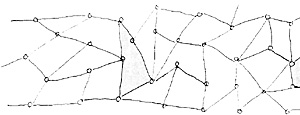The boxed naval board-game, SEASTRIKE, was first published by the WRG people around 1973, and they seem to have sold it to a willing buyer in 1977. I played it once about 8 years ago, and came across a copy of it at HISTORICON.
The heart of SEASTRIKE is a very unique card deck... some 80 cards, on each of which is annotated a host of information. In a way, it reminds me of Avalon Hill's UP FRONT, the infantry board-game, on whose cards are noted so much data, it becomes difficult to digest.
Each of the SEASTRIKE cards has a circle in the middle. When firing shipboard weapons, you draw a card to see if the fire control system of that particular weapons system "locks-on". If there's an "X" in the circle, there's been a lock-on, and the weapons can fire... With no "X", no lock, no firing. Half of the 80 cards have lock-on "X's"... which means that 50 percent of the time, the ships systems fail to fire.
If the system does lock on, you then draw another card or cards, and read the appropriate part of the card to see if there's been a hit on the target. There are provisions for guided missiles, for guns, for depth charges, and for torpedoes.
I thought the 50 percent success rate for lock-on was way too low... if I was CNO, and someone told me my latest missile guidance system worked only 50 percent of the time, I'd shoot the contractor, and then shoot the program officer.
New Seastrike
I thought I'd try to up-date SEASTRIKE, and so I set the card deck aside, and decimalized the system. In going over the procedures, I came up with a required percentage dice toss of 70 percent to have a weapons system lock-on. Trust me, I realize that this figure, too, is absurdly low in terms of system reliability, but as a gaming ploy, it does provide a wee bit of suspense in the game when you discover that your guided missile system's electronics have momentarily failed.
The damage effect in SEASTRIKE is limited to (a) your ship immediately blows up and sinks, or (b) there's been critical damage, and another hit will sink you. Not too much leeway here.
If you're playing a naval game, you've got to have 'hull boxes', and so I went back to the ol' hull box system... I gave each ship its hull boxes (cruiser has 8, frigate has 6, etc.), and I also gave the ship a number of 'weapons system boxes'. A ship's data sheet looks like:

Here, 'SAM' is surface-to-air, 'SSM' is surface-to-surface, and 'GUNS' represent the on-board batteries.
When a ship is hit, you dice to see if (a) the fire control system is hit, or (b) a weapons system is hit, or (c) a hull box is hit. In any case, the appropriate number of boxes is crossed out. Note that on the above data sheet, two hits on the fire control system or on a weapons system renders it inoperable, and brings up an "R" box.
"R" stands for 'repair'... at the end of each half-bound, there's a repair phase, and if a ship is at sea, it's given one 40 percent chance to cross out the fire control "R" and bring up the next two operating boxes, and one chance, again at 40 percent, to cross out one of the weapons system "R" boxes.
In one battle, my cruiser, the fighting Hurst, was plastered due to some excellent dice tosses by my opponent... the ship took 16 hits. She was inundated with missilery from both enemy ships and aircraft... and we started dicing to see just where the hits occurred on-board. After two operating fire control boxes are crossed out, and the two operating boxes of all ship-board weaponry are crossed out, all excess hits are automatically 'transferred' to hull boxes. Since the cruiser only had 8 hull boxes to begin with, she went down immediately, even before CNN came on the scene.
 The SEASTRIKE board is approximately 17 inches by 22 inches... the standard board-game size. There are no hexes, no grids... one just moves his ships 2 inches or 3 inches, or whatever. I expanded the map to full table size, and drew up a 'junction-to-junction' type of map for ship movement. Ships move a total of 4 junctions per half-bound.
The SEASTRIKE board is approximately 17 inches by 22 inches... the standard board-game size. There are no hexes, no grids... one just moves his ships 2 inches or 3 inches, or whatever. I expanded the map to full table size, and drew up a 'junction-to-junction' type of map for ship movement. Ships move a total of 4 junctions per half-bound.
Aircraft, however, don't move from junction to junction... they move from area to area, zipping along at around 10 areas per half-bound. A ship may fire at other ships up to 2 junctions away, and it may also fire at aircraft located in any area adjacent to its junction. Similarly, an aircraft may fire at other aircraft one area away, or at ships located in a junction which touches its own area.
There's a stacking limit of 2 aircraft per area and 2 ships per junction... more than 2, and the field gets too crowded when resolving combat. Restricting ship movement to junctions and aircraft movement to areas, nicely defines the regions in which the appropriate weaponry may strike. There's no range measuring... you're either next to your target or you're not.
Back to PW Review September 1997 Table of Contents
Back to PW Review List of Issues
Back to MagWeb Master Magazine List
© Copyright 1997 Wally Simon
This article appears in MagWeb (Magazine Web) on the Internet World Wide Web.
Other military history articles and gaming articles are available at http://www.magweb.com